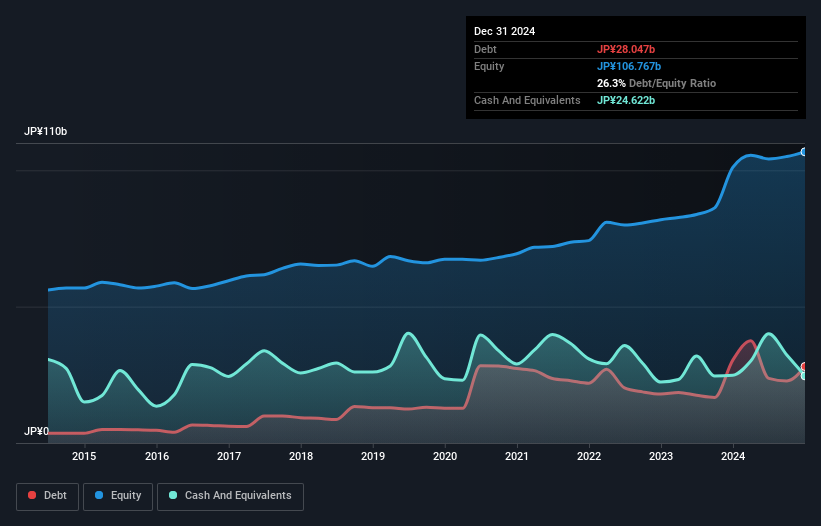We Think Tsukishima Holdings (TSE:6332) Can Stay On Top Of Its Debt

David Iben put it well when he said, 'Volatility is not a risk we care about. What we care about is avoiding the permanent loss of capital.' So it might be obvious that you need to consider debt, when you think about how risky any given stock is, because too much debt can sink a company. We note that Tsukishima Holdings Co., Ltd. (TSE:6332) does have debt on its balance sheet. But is this debt a concern to shareholders?
We've discovered 2 warning signs about Tsukishima Holdings. View them for free.When Is Debt Dangerous?
Generally speaking, debt only becomes a real problem when a company can't easily pay it off, either by raising capital or with its own cash flow. Part and parcel of capitalism is the process of 'creative destruction' where failed businesses are mercilessly liquidated by their bankers. However, a more common (but still painful) scenario is that it has to raise new equity capital at a low price, thus permanently diluting shareholders. By replacing dilution, though, debt can be an extremely good tool for businesses that need capital to invest in growth at high rates of return. When we think about a company's use of debt, we first look at cash and debt together.
What Is Tsukishima Holdings's Net Debt?
The image below, which you can click on for greater detail, shows that Tsukishima Holdings had debt of JP¥28.0b at the end of December 2024, a reduction from JP¥30.4b over a year. However, it also had JP¥24.6b in cash, and so its net debt is JP¥3.43b.

How Healthy Is Tsukishima Holdings' Balance Sheet?
According to the last reported balance sheet, Tsukishima Holdings had liabilities of JP¥47.8b due within 12 months, and liabilities of JP¥33.6b due beyond 12 months. Offsetting these obligations, it had cash of JP¥24.6b as well as receivables valued at JP¥61.6b due within 12 months. So it can boast JP¥4.88b more liquid assets than total liabilities.
This surplus suggests that Tsukishima Holdings has a conservative balance sheet, and could probably eliminate its debt without much difficulty.
See our latest analysis for Tsukishima Holdings
We use two main ratios to inform us about debt levels relative to earnings. The first is net debt divided by earnings before interest, tax, depreciation, and amortization (EBITDA), while the second is how many times its earnings before interest and tax (EBIT) covers its interest expense (or its interest cover, for short). The advantage of this approach is that we take into account both the absolute quantum of debt (with net debt to EBITDA) and the actual interest expenses associated with that debt (with its interest cover ratio).
Tsukishima Holdings has a low debt to EBITDA ratio of only 0.27. But the really cool thing is that it actually managed to receive more interest than it paid, over the last year. So there's no doubt this company can take on debt while staying cool as a cucumber. Even more impressive was the fact that Tsukishima Holdings grew its EBIT by 146% over twelve months. If maintained that growth will make the debt even more manageable in the years ahead. The balance sheet is clearly the area to focus on when you are analysing debt. But you can't view debt in total isolation; since Tsukishima Holdings will need earnings to service that debt. So if you're keen to discover more about its earnings, it might be worth checking out this graph of its long term earnings trend.
Finally, while the tax-man may adore accounting profits, lenders only accept cold hard cash. So we clearly need to look at whether that EBIT is leading to corresponding free cash flow. In the last three years, Tsukishima Holdings created free cash flow amounting to 13% of its EBIT, an uninspiring performance. That limp level of cash conversion undermines its ability to manage and pay down debt.
Our View
Tsukishima Holdings's interest cover suggests it can handle its debt as easily as Cristiano Ronaldo could score a goal against an under 14's goalkeeper. But, on a more sombre note, we are a little concerned by its conversion of EBIT to free cash flow. Zooming out, Tsukishima Holdings seems to use debt quite reasonably; and that gets the nod from us. While debt does bring risk, when used wisely it can also bring a higher return on equity. The balance sheet is clearly the area to focus on when you are analysing debt. But ultimately, every company can contain risks that exist outside of the balance sheet. For instance, we've identified 2 warning signs for Tsukishima Holdings (1 is significant) you should be aware of.
If you're interested in investing in businesses that can grow profits without the burden of debt, then check out this free list of growing businesses that have net cash on the balance sheet.
Valuation is complex, but we're here to simplify it.
Discover if Tsukishima Holdings might be undervalued or overvalued with our detailed analysis, featuring fair value estimates, potential risks, dividends, insider trades, and its financial condition.
Access Free AnalysisHave feedback on this article? Concerned about the content? Get in touch with us directly. Alternatively, email editorial-team (at) simplywallst.com.
This article by Simply Wall St is general in nature. We provide commentary based on historical data and analyst forecasts only using an unbiased methodology and our articles are not intended to be financial advice. It does not constitute a recommendation to buy or sell any stock, and does not take account of your objectives, or your financial situation. We aim to bring you long-term focused analysis driven by fundamental data. Note that our analysis may not factor in the latest price-sensitive company announcements or qualitative material. Simply Wall St has no position in any stocks mentioned.
About TSE:6332
Tsukishima Holdings
Provides products and services for water and sewer facilities in Japan and internationally.
Excellent balance sheet established dividend payer.
Market Insights
Community Narratives



